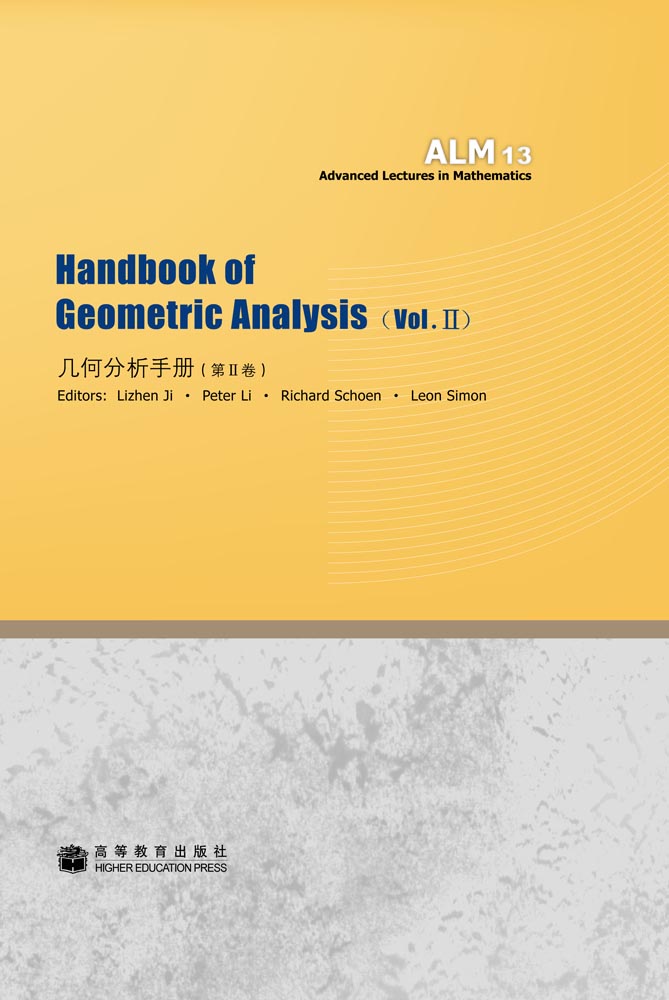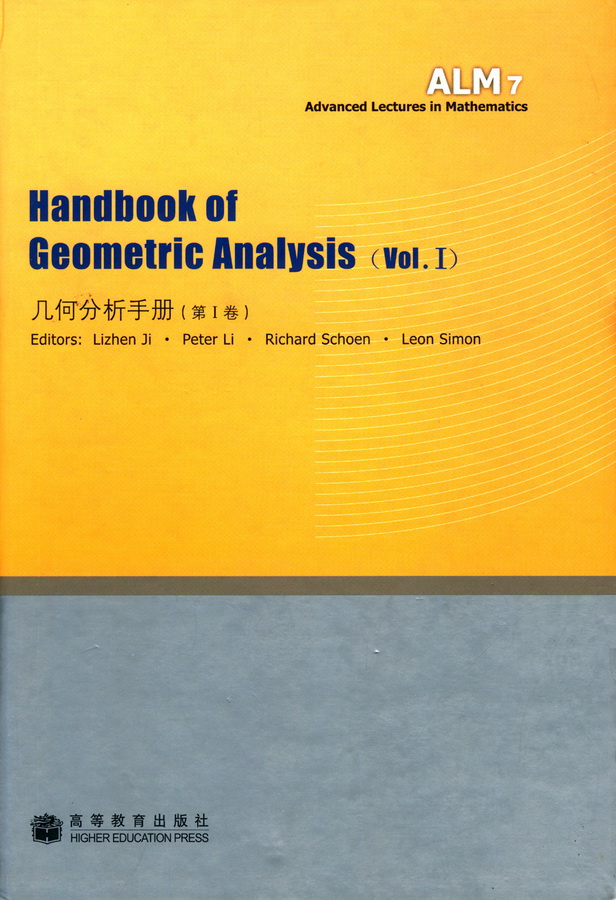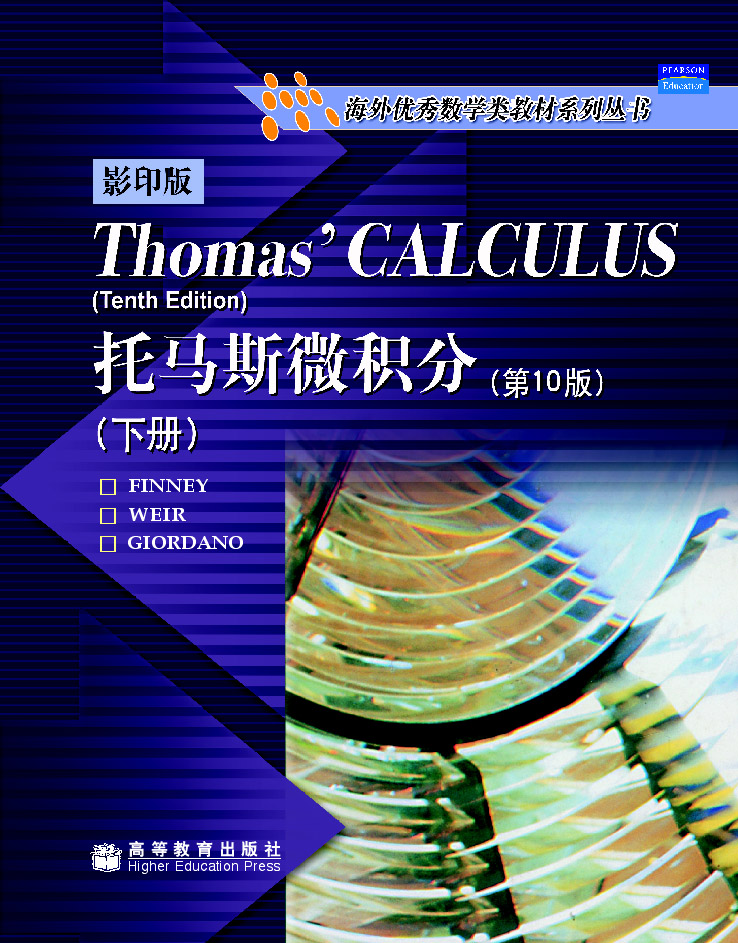几何分析手册(第II卷 英文版)
作者: Lizhen Ji等主编
出版时间:2010-04
出版社:高等教育出版社
- 高等教育出版社
- 9787040288834
- 1版
- 227495
- 48266041-2
- 精装
- 16开
- 2010-04
- 720
- 431
- 理学
- 数学类
- O18-62
- 数学几何
- 研究生及以上
Geometric Analysis combines differential equations and differential geometry. An important aspect is to solve geometric problems by studying differential sides some known linear differential operators such as the Laplace operator,many differential equations arising from differential geometry are nonlinear. A particularly important example is the IVlonge-Ampere equation; Applications to geometric problems have also motivated new methods and techniques in differen-rial equations. The field of geometric analysis is broad and has had many striking applications. This handbook of geometric analysis provides introductions to and surveys of important topics in geometric analysis and their applications to related fields which is intend to be referred by graduate students and researchers in related areas.
Front Matter
Heat Kernels on Metric Measure Spaces with Regular Volume Growth Alexander Grigor’yan
1 Introduction
2 Abstract heat kernels
3 Besov spaces
4 The energy domain
5 The walk dimension
6 Two-sided estimates in the local case
References
A Convexity Theorem and Reduced Delzant Spaces Bong H Lian, Bailin Song
1 Introduction
2 Convexity of image of moment map
3 Rationality of moment polytope
4 Realizing reduced Delzant spaces
5 Classi_cation of reduced Delzant spaces
References
Localization and some Recent Applications Bong H Lian, Kefeng Liu
1 Introduction
2 Localization
3 Mirror principle
4 Hori-Vafa formula
5 The Mari~no-Vafa Conjecture
6 Two partition formula
7 Theory of topological vertex
8 Gopakumar-Vafa conjecture and indices of elliptic operators8
9 Two proofs of the ELSV formula
10 A localization proof of the Witten conjecture
11 Final remarks
References
Gromov-Witten Invariants of Toric Calabi-Yau Threefolds Chiu-Chu Melissa Liu
1 Gromov-Witten invariants of Calabi-Yau 3-folds
1.1 Symplectic and algebraic Gromov-Witten invariants
1.2 Moduli space of stable maps
1.3 Gromov-Witten invariants of compact Calabi-Yau 3-folds
1.4 Gromov-Witten invariants of noncompact Calabi-Yau 3-folds
2 Traditional algorithm in the toric case
2.1 Localization
2.2 Hodge integrals
3 Physical theory of the topological vertex
4 Mathematical theory of the topological vertex
4.1 Locally planar trivalent graph
4.2 Formal toric Calabi-Yau (FTCY) graphs
4.3 Degeneration formula
4.4 Topological vertex
4.5 Localization
4.6 Framing dependence
4.7 Combinatorial expression
4.8 Applications
4.9 Comparison.
5 GW/DT correspondences and the topological vertex
Acknowledgments
References
Survey on A_ne Spheres John Loftin
1 Introduction
2 A_ne structure equations
3 Examples
4 Two-dimensional a_ne spheres and Titeica’s equation
5 Monge-Amp_ere equations and duality
6 Global classi_cation of a_ne spheres
7 Hyperbolic a_ne spheres and invariants of convex cones
8 Projective manifolds
9 A_ne manifolds
10 A_ne maximal hypersurfaces
11 A_ne normal ow
References
Convergence and Collapsing Theorems in Riemannian Geometry Xiaochun Rong
Introduction
1 Gromov-Hausdor_ distance in space of metric spaces
1.1 The Gromov-Hausdor_ distance
1.2 Examples
1.3 An alternative formulation of GH-distance
1.4 Compact subsets of (Met, dGH)
1.5 Equivariant GH-convergence
1.6 Pointed GH-convergence
2 Smooth limits-_brations
2.1 The _bration theorem
2.2 Sectional curvature comparison
2.3 Embedding via distance functions
2.4 Fibrations
2.5 Proof of theorem 2.1.1
2.6 Center of mass
2.7 Equivariant _brations
2.8 Applications of the _bration theorem
3 Convergence theorems
3.1 Cheeger-Gromov’s convergence theorem
3.2 Injectivity radius estimate
3.3 Some elliptic estimates
3.4 Harmonic radius estimate
3.5 Smoothing metrics
4 Singular limits-singular _brations
4.1 Singular _brations
4.2 Controlled homotopy structure by geometry
4.3 The _2-_niteness theorem
4.4 Collapsed manifolds with pinched positive sectional curvature
5 Almost at manifolds
5.1 Gromov’s theorem on almost at manifolds
5.2 The Margulis lemma
5.3 Flat connections with small torsion
5.4 Flat connection with a parallel torsion
5.5 Proofs|part I
5.6 Proofs|part II
5.7 Re_ned _bration theorem
References
Geometric Transformations and Soliton Equations Chuu-Lian Terng
1 Introduction
2 The moving frame method for submanifolds
3 Line congruences and Backlund transforms
4 Sphere congruences and Ribaucour transforms
5 Combescure transforms, O-surfaces, and k-tuples
6 From moving frame to Lax pair
7 Soliton hierarchies constructed from symmetric spaces
8 The UK-system and the Gauss-Codazzi equations
9 Loop group actions
10 Action of simple elements and geometric transforms
References
Affine Integral Geometry from a Di_erentiable Viewpoint Deane Yang
1 Introduction
2 Basic de_nitions and notation
2.1 Linear group actions
3 Objects of study
3.1 Geometric setting
3.2 Convex body
3.3 The space of all convex bodies
3.4 Valuations
4 Overall strategy
5 Fundamental constructions
5.1 The support function
5.2 The Minkowski sum
5.3 The polar body
5.4 The inverse Gauss map
5.5 The second fundamental form
5.6 The Legendre transform
5.7 The curvature function
6 The homogeneous contour integral
6.1 Homogeneous functions and di_erential forms
6.2 The homogeneous contour integral for a di_erential form
6.3 The homogeneous contour integral for a measure
6.4 Homogeneous integral calculus
7 An explicit construction of valuations
7.1 Duality
7.2 Volume
8 Classi_cation of valuations
9 Scalar valuations
9.1 SL(n)-invariant valuations
9.2 Hug’s theorem
10 Continuous GL(n)-homogeneous valuations
10.1 Scalar valuations
10.2 Vector-valued valuations
11 Matrix-valued valuations
11.1 The Cramer-Rao inequality
12 Homogeneous function- and convex body-valued valuations3
13 Questions
References
Classi_cation of Fake Projective Planes Sai-Kee Yeung
1 Introduction
2 Uniformization of fake projective planes
3 Geometric estimates on the number of fake projective planes
4 Arithmeticity of lattices associated to fake projective planes
5 Covolume formula of Prasad
6 Formulation of proof
7 Statements of the results
8 Further studies
References
版权










